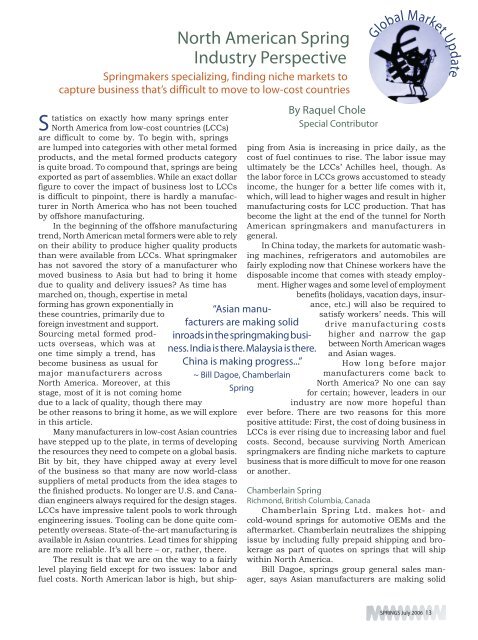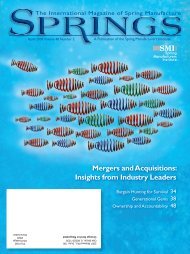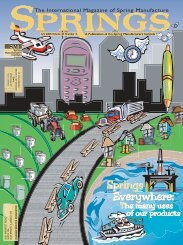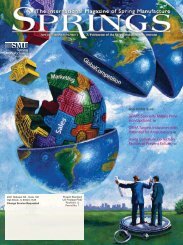Solid Height - Spring Manufacturers Institute
Solid Height - Spring Manufacturers Institute
Solid Height - Spring Manufacturers Institute
Create successful ePaper yourself
Turn your PDF publications into a flip-book with our unique Google optimized e-Paper software.
S tatistics<br />
North American <strong>Spring</strong><br />
Industry Perspective<br />
<strong>Spring</strong>makers specializing, finding niche markets to<br />
capture business that’s difficult to move to low-cost countries<br />
on exactly how many springs enter<br />
North America from low-cost countries (LCCs)<br />
are difficult to come by. To begin with, springs<br />
are lumped into categories with other metal formed<br />
products, and the metal formed products category<br />
is quite broad. To compound that, springs are being<br />
exported as part of assemblies. While an exact dollar<br />
figure to cover the impact of business lost to LCCs<br />
is difficult to pinpoint, there is hardly a manufacturer<br />
in North America who has not been touched<br />
by offshore manufacturing.<br />
In the beginning of the offshore manufacturing<br />
trend, North American metal formers were able to rely<br />
on their ability to produce higher quality products<br />
than were available from LCCs. What springmaker<br />
has not savored the story of a manufacturer who<br />
moved business to Asia but had to bring it home<br />
due to quality and delivery issues? As time has<br />
marched on, though, expertise in metal<br />
forming has grown exponentially in<br />
these countries, primarily due to<br />
foreign investment and support.<br />
Sourcing metal formed products<br />
overseas, which was at<br />
one time simply a trend, has<br />
become business as usual for<br />
major manufacturers across<br />
North America. Moreover, at this<br />
stage, most of it is not coming home<br />
due to a lack of quality, though there may<br />
be other reasons to bring it home, as we will explore<br />
in this article.<br />
Many manufacturers in low-cost Asian countries<br />
have stepped up to the plate, in terms of developing<br />
the resources they need to compete on a global basis.<br />
Bit by bit, they have chipped away at every level<br />
of the business so that many are now world-class<br />
suppliers of metal products from the idea stages to<br />
the finished products. No longer are U.S. and Canadian<br />
engineers always required for the design stages.<br />
LCCs have impressive talent pools to work through<br />
engineering issues. Tooling can be done quite competently<br />
overseas. State-of-the-art manufacturing is<br />
available in Asian countries. Lead times for shipping<br />
are more reliable. It’s all here – or, rather, there.<br />
The result is that we are on the way to a fairly<br />
level playing field except for two issues: labor and<br />
fuel costs. North American labor is high, but ship-<br />
“Asian manufacturers<br />
are making solid<br />
inroads in the springmaking business.<br />
India is there. Malaysia is there.<br />
China is making progress...”<br />
~ Bill Dagoe, Chamberlain<br />
<strong>Spring</strong><br />
By Raquel Chole<br />
Special Contributor<br />
Global Market Update<br />
ping from Asia is increasing in price daily, as the<br />
cost of fuel continues to rise. The labor issue may<br />
ultimately be the LCCs’ Achilles heel, though. As<br />
the labor force in LCCs grows accustomed to steady<br />
income, the hunger for a better life comes with it,<br />
which, will lead to higher wages and result in higher<br />
manufacturing costs for LCC production. That has<br />
become the light at the end of the tunnel for North<br />
American springmakers and manufacturers in<br />
general.<br />
In China today, the markets for automatic washing<br />
machines, refrigerators and automobiles are<br />
fairly exploding now that Chinese workers have the<br />
disposable income that comes with steady employment.<br />
Higher wages and some level of employment<br />
benefits (holidays, vacation days, insur-<br />
ance, etc.) will also be required to<br />
satisfy workers’ needs. This will<br />
drive manufacturing costs<br />
higher and narrow the gap<br />
between North American wages<br />
and Asian wages.<br />
How long before major<br />
manufacturers come back to<br />
North America? No one can say<br />
for certain; however, leaders in our<br />
industry are now more hopeful than<br />
ever before. There are two reasons for this more<br />
positive attitude: First, the cost of doing business in<br />
LCCs is ever rising due to increasing labor and fuel<br />
costs. Second, because surviving North American<br />
springmakers are finding niche markets to capture<br />
business that is more difficult to move for one reason<br />
or another.<br />
Chamberlain <strong>Spring</strong><br />
Richmond, British Columbia, Canada<br />
Chamberlain <strong>Spring</strong> Ltd. makes hot- and<br />
cold-wound springs for automotive OEMs and the<br />
aftermarket. Chamberlain neutralizes the shipping<br />
issue by including fully prepaid shipping and brokerage<br />
as part of quotes on springs that will ship<br />
within North America.<br />
Bill Dagoe, springs group general sales manager,<br />
says Asian manufacturers are making solid<br />
SPRINGS July 2006 13





